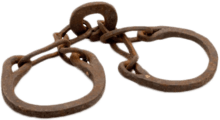Slavery in Britain
Slavery in Great Britain existed and was recognised from before the Roman occupation until the 12th century, when chattel slavery disappeared, at least for a time, after the Norman Conquest. Former slaves merged into the larger body of serfs in Britain and no longer were recognized separately in law or custom.[1][2]
From the 17th century into the 19th century, transportation to the colonies as a criminal or an indentured servant served as punishment for both serious and petty crimes, or for simply being poor and viewed as an 'undesirable', facilitated by the Transportation Act of 1717.[3] During the same period, workhouses employed people whose poverty left them no other alternative than to work under forced labour conditions.
International slave trade
Britain exported slaves from pre-Roman times,[4] but British merchants became major participants in the Atlantic slave trade in the early modern period. Then British people living within the British Isles, as well as in British colonies, might own African slaves. In a triangular trade-system, ship-owners transported enslaved West Africans, as well as British natives, to the New World (especially to the Caribbean) to be sold there. The ships brought commodities back to Britain then exported goods to Africa. Some entrepreneurs brought slaves to Britain,[5] where they were kept in bondage. After a long campaign for abolition led by Thomas Clarkson and (in the House of Commons) by William Wilberforce, Parliament prohibited dealing in slaves by passing the Slave Trade Act 1807, which the Royal Navy's West Africa Squadron enforced. Britain used its influence to persuade other countries around the world to abolish the slave trade and to sign treaties to allow the Royal Navy to interdict slaving ships.[6]
Abolition
Somersett's case in 1772 held that slavery had no basis in English law and was thus a violation of Habeas Corpus. This built on the earlier Cartwright case from the Reign of Elizabeth I which had similarly held the concept of slavery was not recognised in English law. This case was generally taken at the time to have decided that the condition of slavery did not exist under English law. Legally ("de jure") slave owners could not win in court, and abolitionists provided legal help for enslaved black people. However actual ("de facto") slavery continued in Britain with ten to fourteen thousand slaves in England and Wales, who were mostly domestic servants. When slaves were brought in from the colonies they had to sign waivers that made them indentured servants while in Britain. Most modern historians generally agree that slavery continued in Britain into the late 18th century, finally disappearing around 1800.[7] Slavery elsewhere in the British Empire was not affected--indeed it grew rapidly especially in the Caribbean colonies. Slavery was abolished by buying out the owners in 1833 by the Slavery Abolition Act 1833. Most slaves were freed, with exceptions and delays provided for the East India Company, Ceylon, and Saint Helena. These exceptions were eliminated in 1843.[8]
The prohibition on slavery and servitude is now codified under Article 4 of the European Convention on Human Rights, in force since 1953 and incorporated directly into United Kingdom law by the Human Rights Act 1998. Article 4 of the Convention also bans forced or compulsory labour, with some exceptions such as a criminal penalty or military service.
Before 1066
From before Roman times, slavery was normal in Britain, with slaves being routinely exported.[9][10] Slavery continued as an accepted part of society under the Roman Empire and after; Anglo-Saxons continued the slave system, sometimes in league with Norse traders often selling slaves to the Irish.[11] In 870, Vikings besieged and captured the stronghold of Alt Clut (the capital of the Kingdom of Strathclyde) and in 871 took most of the site's inhabitants, most likely by Olaf the White and Ivar the Boneless, to the Dublin slave markets.[12] Maredudd ab Owain (d. 999) paid a large ransom for 2,000 Welsh slaves,[12] which demonstrates the large-scale slave raiding upon the British Isles. Vikings traded with the Gaelic, Pictish, Brythonic and Saxon kingdoms in between raiding them for slaves.[12]
Some of the earliest accounts of the Anglo-Saxon English comes from the account of the fair-haired boys from York seen in Rome by Pope Gregory the Great. In the 7th century the English slave Balthild rose to be queen of the Frankish king Clovis II. Anglo-Saxon opinion turned against the sale of English abroad: a law of Ine of Wessex stated that anyone selling his own countryman, whether bond or free, across the sea, was to pay his own weregild in penalty, even when the man so sold was guilty of crime.[13]
Nevertheless, legal penalties and economic pressures that led to default in payments maintained the supply of slaves, and in the 11th century there was still a slave trade operating out of Bristol, as a passage in the Vita Wulfstani makes clear.[14][2]
Norman England
According to the Domesday Book census, over 10% of England's population in 1086 were slaves.[15] In 1102, the Church Council of London convened by Anselm issued a decree: "Let no one dare hereafter to engage in the infamous business, prevalent in England, of selling men like animals."[16] However, the Council had no legislative powers, and no act of law was valid unless signed by the monarch.
The influence of the new Norman aristocracy led to the decline of slavery in England. Contemporary writers noted that the Scottish and Welsh took captives as slaves during raids, a practice which was no longer common in England by the 12th century. By the start of the 13th century references to people being taken as slaves stopped. While there was no legislation against slavery,[17] William the Conqueror introduced a law preventing the sale of slaves overseas.[18] According to historian John Gillingham, by about 1200 slavery in the British Isles was non-existent.[17]
Transportation
Transportation to the colonies as a criminal or an indentured servant served as punishment for both great and petty crimes in England from the 17th century until well into the 19th century. A sentence could be for life or for a specific period. The penal system required convicts to work on government projects such as road construction, building works and mining, or assigned them to free individuals as unpaid labour. Women were expected to work as domestic servants and farm labourers. Like slaves, indentured servants could be bought and sold, could not marry without the permission of their owner, were subject to physical punishment, and saw their obligation to labour enforced by the courts. However, they did retain certain heavily restricted rights; this contrasts with slaves who had none.
A convict who had served part of his time might apply for a "ticket of leave", granting them some prescribed freedoms. This enabled some convicts to resume a more normal life, to marry and raise a family, and enabled a few to develop the colonies while removing them from the society. Exile was an essential component, and was thought to be a major deterrent to crime. Transportation was also seen as a humane and productive alternative to execution, which would most likely have been the sentence for many if transportation had not been introduced.
The transportation of English subjects overseas can be traced back to the English Vagabonds Act 1597. During the reign of Henry VIII, an estimated 72,000 people were put to death for a variety of crimes.[19] An alternative practice, borrowed from the Spanish, was to commute the death sentence and allow the use of convicts as a labour force for the colonies. One of the first references to a person being transported comes in 1607 when "an apprentice dyer was sent to Virginia from Bridewell for running away with his master's goods."[20] The Act was little used despite attempts by James I who, with limited success, tried to encourage its adoption by passing a series of Privy Council Orders in 1615, 1619 and 1620.[21]
Transportation was seldom used as a criminal sentence until the Piracy Act 1717, "An Act for the further preventing Robbery, Burglary, and other Felonies, and for the more effectual Transportation of Felons, and unlawful Exporters of Wool; and for declaring the Law upon some Points relating to Pirates", established a seven-year penal transportation as a possible punishment for those convicted of lesser felonies, or as a possible sentence to which capital punishment might be commuted by royal pardon. Criminals were transported to North America from 1718 to 1776. When the American revolution made transportation to the Thirteen Colonies unfeasible, those sentenced to it were typically punished with imprisonment or hard labour instead. From 1787 to 1868, criminals convicted and sentenced under the Act were transported to the colonies in Australia.
After the Irish Rebellion of 1641 and subsequent Cromwellian invasion, the English Parliament passed the Act for the Settlement of Ireland 1652 which classified the Irish population into several categories according to their degree of involvement in the uprising and the subsequent war. Those who had participated in the uprising or assisted the rebels in any way were sentenced to be hanged and to have their property confiscated. Other categories were sentenced to banishment with whole or partial confiscation of their estates. While the majority of the resettlement took place within Ireland to the province of Connaught, perhaps as many as 50,000 were transported to the colonies in the West Indies and in North America.[22] During the early colonial period, the Scots and the English, along with other western European nations, dealt with their "Gypsy problem" by transporting them as slaves in large numbers to North America and the Caribbean. Cromwell shipped Romanichal Gypsies as slaves to the southern plantations, and there is documentation of Gypsies being owned by former black slaves in Jamaica.[23]
Long before the Highland Clearances, some chiefs, such as Ewen Cameron of Lochiel, sold some of their clans into indenture in North America. Their goal was to alleviate over-population and lack of food resources in the glens.
Numerous Highland Jacobite supporters, captured in the aftermath of the Battle of Culloden and rigorous Government sweeps of the Highlands, were imprisoned on ships on the River Thames. Some were sentenced to transportation to the Carolinas as indentured servants.[24]
Slavery and bondage in Scottish collieries
For nearly two hundred years in the history of coal mining in Scotland, miners were bonded to their "maisters" by a 1606 Act "Anent Coalyers and Salters". The Colliers and Salters (Scotland) Act 1775 stated that "many colliers and salters are in a state of slavery and bondage" and announced emancipation; those starting work after 1 July 1775 would not become slaves, while those already in a state of slavery could, after 7 or 10 years depending on their age, apply for a decree of the Sheriff's Court granting their freedom. Few could afford this, until a further law in 1799 established their freedom and made this slavery and bondage illegal.[25][26]
Workhouse slavery
From the 17th century to the 19th century, workhouses took in people whose poverty left them no other alternative. They were employed under forced labour conditions. Workhouses took in abandoned babies, usually presumed to be illegitimate. When they grew old enough, they were used as child labour. Charles Dickens represented such issues in his fiction. A life example was Henry Morton Stanley. This was a time when many children worked; if families were poor, everyone worked. Only in 1833 and 1844 were the first general protective laws against child labour, the Factory Acts, passed in Britain.[27]
Barbary pirates
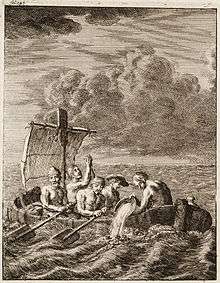
From the 16th to the 19th centuries it is estimated that between 1 million and 1.25 million Europeans were captured by Barbary pirates and Barbary slave traders and sold as slaves. The slavers got their name from the Barbary Coast, that is, the Mediterranean shores of North Africa – what is now Morocco, Algeria, Tunisia, and Libya. There are reports of Barbary raids and kidnappings of those in France, Ireland, Italy, Portugal, Spain, and the United Kingdom and as far north as Iceland and the fate of those abducted into slavery in North Africa and the Ottoman Empire.[28]
Villagers along the south coast of England petitioned the king to protect them from abduction by Barbary pirates. Item 20 of The Grand Remonstrance,[29] a list of grievances against Charles I presented to him in 1641, contains the following complaint about Barbary pirates of the Ottoman Empire abducting English people into slavery:
And although all this was taken upon pretense of guarding the seas, yet a new unheard-of tax of ship-money was devised, and upon the same pretense, by both which there was charged upon the subject near £700,000 some years, and yet the merchants have been left so naked to the violence of the Turkish pirates, that many great ships of value and thousands of His Majesty's subjects have been taken by them, and do still remain in miserable slavery.
Enslaved Africans
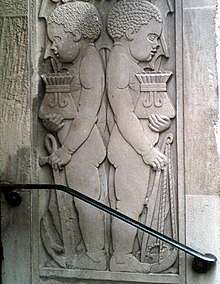
Admiral Sir John Hawkins of Plymouth, a notable Elizabethan seafarer, is widely acknowledged to be "the Pioneer of the English Slave Trade". In 1554–1555, Hawkins formed a slave trading syndicate of wealthy merchants. He sailed with three ships for the Caribbean via Sierra Leone, hijacked a Portuguese slave ship and sold the 300 slaves from it in Santo Domingo. During a second voyage in 1564, his crew captured 400 Africans and sold them at Rio de la Hacha in present-day Colombia, making a 60% profit for his financiers. A third voyage involved both buying slaves directly in Africa and capturing a Portuguese ship with its cargo; upon reaching the Caribbean, Hawkins sold all the slaves. On his return, he published a book entitled An Alliance to Raid for Slaves.[30] It is estimated that Hawkins transported 1,500 enslaved Africans across the Atlantic during his four voyages of the 1560s, before stopping in 1568 after a battle with the Spanish in which he lost five of his seven ships. The English involvement in the Atlantic slave trade only resumed in the 1640s after the country acquired an American colony (Virginia).[31]
By the mid 18th century, London had the largest African population in Britain, made up of free and enslaved people, as well as many runaways. The total number may have been about 10,000.[32] Owners of African slaves in England would advertise slave-sales and rewards for the recapture of runaways.[33][34]
A number of freed slaves managed to achieve prominence in British society. Ignatius Sancho (1729–1780), known as 'The Extraordinary Negro', opened his own grocer's shop in Westminster. He was famous for his poetry and music, and his friends included the novelist Laurence Sterne, David Garrick the actor and the Duke and Duchess of Montague. He is best known for his letters which were published after his death. Others such as Olaudah Equiano and Ottobah Cugoano were equally well known, and along with Ignatius Sancho were active in the abolition campaign.
Triangular trade
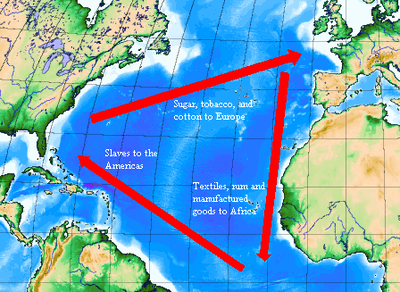
By the 18th century, the slave trade became a major economic mainstay for such cities as Bristol, Liverpool and Glasgow, engaged in the so-called "Triangular trade". The ships set out from Britain, loaded with trade goods which were exchanged on the West African shores for slaves captured by local rulers from deeper inland; the slaves were transported through the infamous "Middle Passage" across the Atlantic, and were sold at considerable profit for labour in plantations. The ships were loaded with export crops and commodities, the products of slave labour, such as sugar and rum, and returned to Britain to sell the items.
The Isle of Man and the transatlantic slave trade
The Isle of Man was involved in the transatlantic African slave trade. Goods from the slave trade were bought and sold on the Isle of Man, and Manx merchants, seamen, and ships were involved in the trade.[35]
Judicial decisions
No legislation was ever passed in England that legalised slavery, unlike the Portuguese Ordenações Manuelinas (1481–1514), the Dutch East India Company Ordinances (1622), and France's Code Noir (1685), and this caused confusion when Englishmen brought home slaves they had legally purchased in the colonies.[36][37] John Locke, the philosophical champion of the Glorious Revolution, asserted that "every man has property in his own person" but allowed for the enslavement of war captives --a popular defense of slavery throughout the seventeenth, eighteenth, and nineteenth centuries in England (§27, Ch.V=; II.iv.24). Locke also had stock in the Royal Africa Company. In Butts v. Penny (1677) 2 Lev 201, 3 Keb 785, an action was brought to recover the value of 10 slaves who had been held by the plaintiff in India. The court held that an action for trover would lie in English law, because the sale of non-Christians as slaves was common in India. However, no judgment was delivered in the case.[38][39]
An English court case of 1569 involving Cartwright who had bought a slave from Russia ruled that English law could not recognise slavery. This ruling was overshadowed by later developments, particularly in the Navigation Acts, but was upheld by the Lord Chief Justice in 1701 when he ruled that a slave became free as soon as he arrived in England. [40]
Agitation saw a series of judgments repulse the tide of slavery. In Smith v. Gould (1705–07) 2 Salk 666, John Holt (Lord Chief Justice) stated that by "the common law no man can have a property in another". (See the "infidel rationale".)
In 1729 the Attorney General and Solicitor General of England signed the Yorke–Talbot slavery opinion, expressing their view (and, by implication, that of the Government) that slavery of Africans was lawful in England. At this time slaves were openly bought and sold on commodities markets at London and Liverpool. Slavery was also accepted in Britain's many colonies.
Lord Henley LC said in Shanley v. Harvey (1763) 2 Eden 126, 127 that as "soon as a man sets foot on English ground he is free".
After R v. Knowles, ex parte Somersett (1772) 20 State Tr 1 the law remained unsettled, although the decision was a significant advance for, at the least, preventing the forceable removal of anyone from England, whether or not a slave, against his will. A man named James Somersett was the slave of a Boston customs officer. They came to England, and Somersett escaped. Captain Knowles captured him and took him on his boat, Jamaica bound. Three abolitionists, saying they were his "godparents", applied for a writ of habeas corpus. One of Somersett's lawyers, Francis Hargrave, stated "In 1569, during the reign of Queen Elizabeth I, a lawsuit was brought against a man for beating another man he had bought as a slave overseas. The record states, 'That in the 11th [year] of Elizabeth [1569], one Cartwright brought a slave from Russia and would scourge him; for which he was questioned; and it was resolved, that England was too pure an air for a slave to breathe in'." He argued that the court had ruled in Cartwright's case that English common law made no provision for slavery, and without a basis for its legality, slavery would otherwise be unlawful as false imprisonment and/or assault.[41] In his judgment of 22 June 1772, Lord Chief Justice William Murray, Lord Mansfield, of the Court of King's Bench, started by talking about the capture and forcible detention of Somersett. He finished with:
So high an act of dominion must be recognized by the law of the country where it is used. The power of a master over his slave has been exceedingly different, in different countries.
The state of slavery is of such a nature, that it is incapable of being introduced on any reasons, moral or political, but only by positive law, which preserves its force long after the reasons, occasion, and time itself from whence it was created, is erased from memory.
It is so odious, that nothing can be suffered to support it, but positive law. Whatever inconveniences, therefore, may follow from the decision, I cannot say this case is allowed or approved by the law of England; and therefore the black must be discharged.[42]
Several different reports of Mansfield's decision appeared. Most disagree as to what was said. The decision was only given orally; no formal written record of it was issued by the court. Abolitionists widely circulated the view that it was declared that the condition of slavery did not exist under English law, although Mansfield later said that all that he decided was that a slave could not be forcibly removed from England against his will.[43]
After reading about Somersett's Case, Joseph Knight, an enslaved African who had been purchased by his master John Wedderburn in Jamaica and brought to Scotland, left him. Married and with a child, he filed a freedom suit, on the grounds that he could not be held as a slave in Great Britain. In the case of Knight v. Wedderburn (1778), Wedderburn said that Knight owed him "perpetual servitude". The Court of Sessions of Scotland ruled against him, saying that chattel slavery was not recognised under the law of Scotland, and slaves could seek court protection to leave a master or avoid being forcibly removed from Scotland to be returned to slavery in the colonies.[44]
Abolition
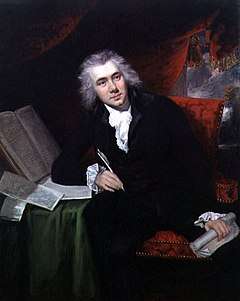
The abolitionist movement was led by Quakers and other Non-conformists, but the Test Act prevented them from becoming Members of Parliament. William Wilberforce, a member of the House of Commons as an independent, became the Parliamentary spokesman for the abolition of the slave trade in Britain. His conversion to Evangelical Christianity in 1784 played a key role in interesting him in this social reform.[45] William Wilberforce's Slave Trade Act 1807 abolished the slave trade in the British Empire. It was not until the Slavery Abolition Act 1833 that the institution finally was abolished, but on a gradual basis. Since land owners in the British West Indies were losing their unpaid labourers, they received compensation totaling £20 million.[46]
The Royal Navy established the West Africa Squadron (or Preventative Squadron) at substantial expense in 1808 after Parliament passed the Slave Trade Act. The squadron's task was to suppress the Atlantic slave trade by patrolling the coast of West Africa, preventing the slave trade by force of arms, including the interception of slave ships from Europe, the United States, the Barbary pirates, West Africa and the Ottoman Empire.
The Church of England was implicated in slavery. Slaves were owned by the Anglican Church's Society for the Propagation of the Gospel in Foreign Parts (SPGFP), which had sugar plantations in the West Indies. When slaves were emancipated by Act of the British Parliament in 1834, the British government paid compensation to slave owners. Among those they paid were the Bishop of Exeter and three business colleagues, who received compensation for 665 slaves.[48]
Modern evaluations of economic impact
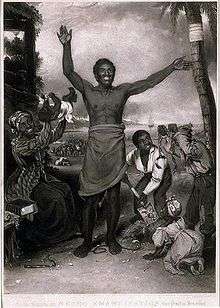
Historians and economists have debated the economic effects of slavery for Great Britain and the North American colonies. Many analysts, such as Eric Williams, suggest that it allowed the formation of capital that financed the Industrial Revolution[49], although the evidence is inconclusive. Slave labour was integral to early settlement of the colonies, which needed more people for labour and other work. Also, slave labour produced the major consumer goods that were the basis of world trade during the eighteenth and early nineteenth centuries: coffee, cotton, rum, sugar, and tobacco. Slavery was far more important to the profitability of plantations and the economy in the American South; and the slave trade and associated businesses were important to both New York and New England.[50]
In 2006, the then British Prime Minister, Tony Blair, expressed his deep sorrow over the slave trade, which he described as "profoundly shameful".[51] Some campaigners had demanded reparations from the former slave trading nations.[52]
In recent years, several institutions have begun to evaluate their own links with slavery. For instance, English Heritage produced a book on the extensive links between slavery and British country houses in 2013, Jesus College has a working group to examine the legacy of slavery within the college, and the Church of England, the Bank of England, Lloyd's of London and Greene King have all apologised for their historic links to slavery.[53][54][55][56][57] UCL has developed a database examining the commercial, cultural, historical, imperial, physical and political legacies of slavery in Britain (see 'external links').
See also
Footnotes
- Maitland, Frederic; Pollock, Frederick (1895), The History of the Laws of England Before the Time of Edward I, Cambridge: Cambridge University Press, p. 34.
- David A. E. Pelteret, Slavery in Early Mediaeval England: From the Reign of Alfred until the Twelfth Century (1995)
- http://www.earlyamericancrime.com/convict-transportation/new-punishment/transportation-act
- Strabo, Geographica, book 4, chapter 5: "Britain, Ireland, and Thule". http://penelope.uchicago.edu/Thayer/E/Roman/Texts/Strabo/4E*.html - "It bears grain, cattle, gold, silver, and iron. These things, accordingly, are exported from the island, as also hides, and slaves, and dogs"
-
Ruane, Michael E. (3 July 2018). "Ads for runaway slaves in British newspapers show the cruelty of the 'genteel'". Washington Post. Retrieved 3 September 2018.
'Few people in Britain think about British ownership of hundreds of thousands of enslaved people, or the fact that some of those Britons brought some of these enslaved people back to Britain [...].'
- Falola, Toyin; Warnock, Amanda (2007). Encyclopedia of the middle passage. Greenwood Press. pp. xxi, xxxiii–xxxiv. ISBN 978-0-313-33480-1.
- William R. Cotter, "The Somerset Case and the Abolition of Slavery in England." History]] 79.255 (1994): 31-56, esp. 44-45.
- "Slavery Abolition Act 1833; Section LXIV". 28 August 1833. Retrieved 3 June 2008.
- Strabo, Geographica book 4 chapter 5: Britain, Ireland, and Thule. http://penelope.uchicago.edu/Thayer/E/Roman/Texts/Strabo/4E*.html "It bears grain, cattle, gold, silver, and iron. These things, accordingly, are exported from the island, as also hides, and slaves, and dogs"
- Museum of Wales. Artefacts from Llyn Cerrig Bach. Gang Chain (Slave Chain) "Archived copy". Archived from the original on 8 June 2010. Retrieved 18 April 2010.CS1 maint: archived copy as title (link)
- Slave Trading in Anglo-Saxon and Viking England
- The Historical encyclopedia of world slavery, Volume 1; Volume 7 By Junius P. Rodriguez ABC-CLIO, 1997
- H. R. Loyn, Anglo-Saxon England and the Norman Conquest, 2nd ed. 1991:90.
- Noted by Loyn 1991:90 note 39.
- Davis, David Brion (1970). The Problem of Slavery in Western Culture. Pelican Books. p. 53.
- Pijper, Frederik (1909). "The Christian Church and Slavery in the Middle Ages". The American Historical Review. American Historical Association. 14 (4): 681. doi:10.1086/ahr/14.4.675. JSTOR 1837055.
- Gillingham, John (2014), "French chivalry in twelfth-century Britain?", The Historian, pp. 8–9
- Hudson, John (2012). The Oxford History of the Laws of England. II (871–1216) (First ed.). Oxford: Oxford University Press. pp. 424–425. ISBN 9780191630033.
- 1911 Encyclopædia Britannica, Capital punishment
- Beier, A.L. (1985) Masterless Men: The Vagrancy Problem in England, 1560–1640, London: Methuen, p. 163
- Balak, Benjamin, and Jonathan M. Lave. 2002. The Dismal Science of Punishment: The Legal-Economy of Convict Transportation to the American Colonies
- "Down Survey". Trinity College Dublin Department of History. Retrieved 19 March 2016.
- "ROMA [GYPSIES] | The Handbook of Texas Online| Texas State Historical Association (TSHA)". 15 June 2010.
- (John Prebble: Culloden 1963)
- "Erskine May on Slavery in Britain (Vol. III, Chapter XI)". Retrieved 2 November 2017.
- James Barrowman, Mining Engineer (14 September 1897). "Slavery In The Coal-Mines Of Scotland". Scottish Mining Website. Retrieved 2 November 2017.
- "The Life of the Industrial Worker in 19th-Century Britain"
- Davis, Robert. "When Europeans Were Slaves: Research Suggests White Slavery Was Much More Common Than Previously Believed". Ohio State University. Archived 25 July 2011 at the Wayback Machine
- "The Grand Remonstrance, with the Petition accompanying it". Constitution Society. Accessed 6 December 2006.
- The Atlantic slave trade. Northrup, David, 1941-. Lexington, Massachusetts. ISBN 0-669-33145-7. OCLC 29293476.CS1 maint: others (link)
- Kaufmann, Miranda (2017). Black Tudors: The Untold Story. Oneworld Publications. ISBN 9781786071859. p.58 & 87.
- "Black people in Europe – International Slavery Museum, Liverpool museums". www.liverpoolmuseums.org.uk. Retrieved 11 October 2016.
- Mohdin, Aamna. "Researchers discovered hundreds of ads for runaway slaves in 18th-century Britain". Quartz. Retrieved 19 June 2018.
- Ruane, Michael E. (3 July 2018). "Ads for runaway slaves in British newspapers show the cruelty of the 'genteel'". Washington Post. Retrieved 3 September 2018.
- "The Isle of Man and the Transatlantic Slave Trade".
- Kaufmann (2017). p.16.
- Kaufmann, Miranda. Slavery and English Common Law in Encyclopaedia of Blacks in European History and Culture (2008),Vol. I, pp. 200–203. Greenwood Press. ISBN 9780313344480
- Freeman, Richard (1826). Reports of Cases Argued and Determined in the Courts of King's Bench (2 ed.). London: S. Sweet and Stevens and Sons. p. 451.
- See also Gelly v. Cleve (1694) 1 Ld Raym 147; later applying different reasoning Chamberlain v. Harvey (1697) 1 Ld Raym 146 and Smith v Gould (1705–07) 2 Salk 666
- V.C.D. Mtubani, African Slaves and English Law, PULA Botswana Journal of African Studies Vol 3 No 2 Nov 1983 retrieved 24 February 2011
- Matter of Cartwright, 11 Elizabeth; 2 Rushworth's Coll 468 (1569)
- Somerset v Stewart Lofft 1–18; 11 Harg. State Trials 339; 20 Howell's State Trials 1, 79–82; 98 Eng Rep 499–510 (King's Bench, 22 June 1772) from Howell's text, http://medicolegal.tripod.com/somersetvstewart.htm#p51-rhc
- See generally, S. M. Wise, Though the Heavens May Fall, Pimlico (2005)
- "Slavery, freedom or perpetual servitude? – the Joseph Knight case". National Archives of Scotland. Retrieved 27 November 2010.
- "William Wilberforce : Biography". Archived from the original on 5 December 2013.
- Oldfield, Dr John (17 February 2011). "British Anti-slavery". BBC History. BBC. Retrieved 2 January 2017.
the new legislation called for the gradual abolition of slavery. Everyone over the age of six on August 1, 1834, when the law went into effect, was required to serve an apprenticeship of four years in the case of domestics and six years in the case of field hands
- "Church apologises for slave trade"
- Barbara Solow and Stanley L. Engerman, eds., British capitalism and Caribbean slavery: The legacy of Eric Williams (Cambridge University Press, 2004)
- "Was slavery the engine of economic growth?" Archived 13 May 2012 at the Wayback Machine, Digital History, University of Houston
- "Blair 'sorrow' over slave trade"
- "Database of Archives of Non-Governmental Organisations". www.dango.bham.ac.uk. Retrieved 11 October 2016.
- Dresser, Madge. Hann, Andrew. (2013). Slavery and the British country house. English Heritage. ISBN 978-1-84802-064-1. OCLC 796755629.CS1 maint: multiple names: authors list (link)
- Mottier, Veronique Athol, Robert Edwards, Michael Grower, Julius Robson, Elly Jeppesen, Christopher Fennell, Shailaja Fenton-Glynn, Claire Morieux, Renaud Clarke, Rohan Taneja, Preti (25 November 2019). Slavery Inquiry Report, Jesus College Cambridge. Jesus College, University of Cambridge. OCLC 1142429215.CS1 maint: multiple names: authors list (link)
- "Bank of England says sorry for slave links as UK faces past". HoustonChronicle.com. 19 June 2020. Retrieved 23 June 2020.
- Togoh, Isabel. "After Aunt Jemima And Uncle Ben, Lloyd's Of London And Britain's Biggest Pub Owner Apologize For Links To Atlantic Slave Trade". Forbes. Retrieved 23 June 2020.
- "Bank and Church of England sorry for slavery ties". www.msn.com. Retrieved 23 June 2020.
Further reading
- Bailey, Mark. The decline of serfdom in late medieval England: from bondage to freedom (Boydell & Brewer Ltd, 20140.
- Burn, W. L. Emancipation and apprenticeship in the British West Indies (1937)
- Cotter, William R. "The Somerset Case and the Abolition of Slavery in England." History 79.255 (1994): 31-56.
- Davis, David Brion. The Problem of Slavery in Western Culture (1966), Pulitzer Prize
- Devine, Tom M. Recovering Scotland's Slavery Past. (Edinburgh U{, 2015).
- Drescher, Seymour. Econocide: British slavery in the era of abolition (U of North Carolina Press, 2010).
- Drescher, Seymour. Abolition: a history of slavery and antislavery (Cambridge UP, 2009).
- Dumas, Paula E. Proslavery Britain: Fighting for slavery in an era of abolition (Springer, 2016).
- Eltis, David, and Stanley L. Engerman. "The importance of slavery and the slave trade to industrializing Britain." Journal of Economic History 60.1 (2000): 123-144. online
- Green, William A. British slave emancipation, the sugar colonies and the great experiment, 1830-1865 (Oxford, 1981)
- Guasco, Michael (2014). Slaves and Englishmen: Human Bondage in the Early Modern Atlantic. University of Pennsylvania Press.
- Kern, Holger Lutz. "Strategies of legal change: Great Britain, international law, and the abolition of the transatlantic slave trade." Journal of the History of International Law/Revue d'histoire du droit international 6.2 (2004): 233-258. online
- Midgley, Clare. Women against slavery: the British campaigns, 1780-1870 (Routledge, 2004).
- Pelteret, David A. E. (1995). Slavery in Early Mediaeval England: From the Reign of Alfred until the Twelfth Century. Woodbridge, UK: The Boydell Press. ISBN 978-0-85115-829-7.
- Quinault, Roland. "Gladstone and slavery." The Historical Journal 52.2 (2009): 363-383. DOI: https://doi.org/10.1017/S0018246X0900750X
- Taylor, Michael. "The British West India interest and its allies, 1823–1833." English Historical Review 133.565 (2018): 1478-1511. https://doi.org/10.1093/ehr/cey336
- Thomas, Hugh. The slave trade: the history of the Atlantic slave trade, 1440-1870 (1997)
- Ward, J. R. British West India slavery: the process of amelioration (Oxford UP, 1988)
- Wiecekt, William M. "Somerset: Lord Mansfield and the legitimacy of slavery in the Anglo-American world." Constitutional Law (Routledge, 2018) pp. 77-138. online
External links
- "Legacies of British Slave-ownership". University College London - Department of History. Retrieved 4 September 2018.
